|
February 5, 2023
Dear Neighbors and Friends,
I hope that you and your loved ones are doing well, staying healthy, and looking out for your neighbors and friends during this past week.
We’ve completed the third full week of the new session and have already had public hearings and even votes on many bills in committee. Some of them already began hitting the House and Senate floors for their first-chamber votes. All of them on the Senate side at least came with unanimous votes out of committee.
Sadly, despite their non-controversial nature, Senate Republicans have decided again to utilize a requirement (one that was always routinely waived until recently) that all bills be read aloud in their entirety. That began on Thursday. We were able to get through a series of very short bills pretty quickly thanks to the electronic reader. Ahead of us this week, sadly, is SB 316, a very routine fix-it bill that is unfortunately 54 pages in length. It will probably require an hour to read.
This requirement in the Oregon Constitution of course dates back to a much earlier day, prior to typing and photocopying. But it is now being used as a political tactic, in the hopes that Democrats will eventually pull back some of their priority bills in order to avoid the session running out of time and thereby killing even more priorities.
Nevertheless, Democrats believes that they can manage the calendar in such a way to prevent that from happening. If it requires additional floor sessions and more time on the floor, I believe that will happen.
On the positive side, I do want to let you know how proud I am of our hybrid committee public hearings. The ability to alternate between remote and in-person testimony has really made our hearings much richer and more democratic. My committee hearings have been attracting voices from all over the state at the same time. It really opens up the process in a positive way. And so far at least (fingers crossed) the technology has worked without any problems. In addition, we now have ASL interpreters at every hearing.
On the COVID front, the steady declines that we have been experiencing over the last few weeks came to an end this week, as we saw small upticks in a few. The number of those in hospital with COVID—the most reliable indicator of the impact of the virus—has continued to decline, however. We are seeing a little more virus in the wastewater analyses. A few other counties have joined Malheur County in being at Medium Risk for COVID, but as has been the case for nearly all of the past few months, none is at High Risk. You’ll see from the graphs at the end of the newsletter that our overall trajectory is moving down.
Although it’s been two weeks since the last update, we didn’t get a new forecast report from OHSU this week. I assume we will next week and I’ll include it next time. Based on the national reporting included in the links towards the end of the newsletter, the nation as a whole appears to be on a downward COVID trajectory, similar to Oregon. Still, nationally, we continue to see 400-500 COVID deaths each day, most of them in older Americans who have not been boosted. The value of boosters for seniors and others most likely to develop severe consequences seems increasingly clear. If you have older friends and relatives living in congregate care who have not yet received the new booster, please do what you can to make sure they have access to it.
Until next week, please do your best to stay happy, healthy and safe. And let me know if you have any questions or thoughts about anything in this week’s newsletter.
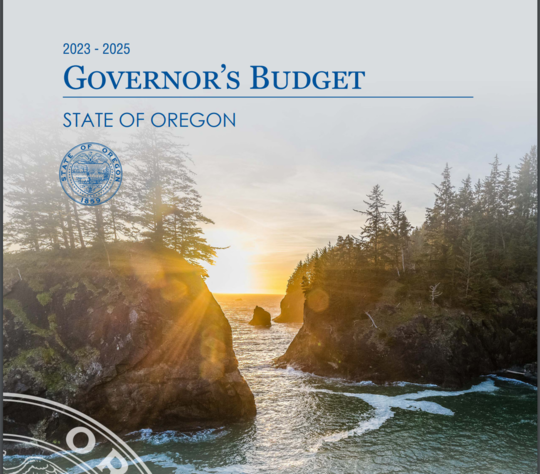
The Governor Releases Her Recommended Budget
As promised, the Governor released her recommended budget this past Tuesday. Along with funding most (though not all) of our current programs, it includes three major priority areas for new investments: housing and homelessness, mental health and addictions, and improving literacy rates for young Oregonians. These areas are priorities for both parties in both chambers.
You’ll find details in the press release that was issued on Tuesday. It contains a description of the budget’s major components, links to the budget documents, and a recording of her press conference. Further down in the newsletter, you'll find a report from the Oregon Health Authority on how the budget would affect health care in Oregon.
As I’ve mentioned before, one of the real challenges in building this year’s budget is that many important programs are currently being funded via the one-time federal dollars that came to us as pandemic relief. These include programs that have proven their worth and proven their value, but unfortunately we don’t have the revenues that can keep them going exclusively via state funds (mainly the income tax). Agencies can keep them going, but to do so they have to eliminate other important programs. In some cases that will happen.
The budget proposal assumes that all of this year’s record windfall kicker (currently estimated at around $3.4 billion) will be returned next year to taxpayers. It would certainly be helpful if we could use some of it to do more to address some of our most pressing problems—housing, homelessness, childcare, inadequate services for children with disabilities, student debt, wildfire, drought—but to do anything other than return it all to taxpayers requires a 2/3 vote of each chamber, which entails some support from Republican legislators.
In accordance with the constitutional change that the voters made in 2012, the budget does put all of the Corporate Kicker in K-12 education, which helps close the gap (though not entirely) between what is needed and what we can invest.
It also assumes that this year we suspend our requirement to put $765 million in additional payments into our reserves--the Rainy Day Fund and the Education Stability Fund. Thanks to legislative self-discipline and a healthy economy over the last decade, our reserves are currently at a very comfortable level, among the best in the country. So her approach makes good sense. But again, to do so will require overcoming some legislative and political hurdles that may or may not be possible. This will not be easy. But if not, we’ll need to make $765 million in cuts for the budget in order for the budget to be balanced.
Now that the Governor’s Recommended Budget (the GRB) has been finalized, the different state agencies will start coming before the various subcommittees of Joint Ways and Means to explain and advocate for their budgets. The subcommittees will ultimately be making recommendations to the full Ways and Means Committee about potential changes to current services and to the GRB. That will be our work over the next five and a half months.
I’ll be reporting on how that process is going.
If you have an interest in any of the agencies that make up state government, I’d recommend that you take a look at the GRB document .Along with the numbers, charts, and tables, you’ll find descriptions of all the agencies and their functions. It’s actually quite readable and useful.
Next Deadline
Deadlines, deadlines. As I’ve mentioned before, legislative deadlines rule the session (though there are always exceptions or occasional work-arounds). Another of them is coming up this month. February 21st is the deadline for bills that have been drafted to be formally filed for introduction.
Several thousand bills have already been filed and posted, but we know there are more out there in various stages of drafting by Legislative Counsel. Those drafts will need to be completed by LC by February 17th. Not all of these drafts will ultimately be filed but many will, either as “personal” bills with one or more sponsors, or as “committee bills” with the committee as sponsor.
I’ve mentioned before that many of the bills that have been posted are just “placeholders,” which may or may not ever need a hearing. If a bill is calling for a study of some sort, it is most likely a placeholder at this point. Some have been filed “just in case” there’s a need for a bill on that general subject and will never get a public hearing. Others may have been the focus of a work group trying to come up with the right approach and end up having the “study” language replaced by real content through the amendment process. If a placeholder bill is scheduled for a public hearing, take a look at any amendments that may have been posted—that’s where you’ll find the real bill.
After the February 21 deadline has passed, legislators (and committees) can still request and file a few “priority” bills. But that’s relatively rare.
The real challenge with filing brand new bills late in the session, though, is that they may not get scheduled. As an example, the Senate Education Committee, which I chair, has had around 150 bills referred to it. We have just 8 weeks left before all Senate bills must either be passed out of committee or die (the deadline for that is April 4). We’ve had public hearings on a dozen bills so far, and it will be hard to schedule more than 50 bills for hearings between now and the April 4th deadline. You see the problem.
By the way, after a bill has had a public hearing, it may or may not be scheduled for a committee “work session,” i.e., a vote. I’ll tell you more about the dynamics of work sessions next time.
Congressman Bentz Named Chair of Water, Wildlife, and Fisheries
My former legislative colleague and now congressman, Cliff Bentz, has been appointed to chair the Water, Wildlife, and Fisheries Subcommittee of the House Natural Resources Committee. This is potentially great news for Oregon, given the importance of these resources for our state.
Below is the announcement from his office. It unfortunately ends on a political note, as he takes the opportunity to criticize President Biden and the Democrats for trying to protect water sources where appropriate to protect fish and wildlife. Unfortunate, but so it goes.

ON THE COVID FRONT
Weekly Data Report:
OHA now updates and reports COVID metrics once a week, on Wednesdays. Here are the most recent set of weekly results, for this past week from 1/27/23 through 2/1/23.
This week’s report shows a slight return to increases in most of the metrics.
- The 7-day average for newly reported infections went up last week, from 290 the previous week to 330 reported infections per day this last week (roughly where it was two weeks ago). The number of new cases is again likely an undercount, as many people are using home tests to determine their infection status but are not reporting those results.
- Average test positivity also went up during the last week, to 8.8% vs. the previous week’s 7.6%. This number probably skews high because it likely reflects a higher proportion of people showing COVID symptoms (and thus reporting or going in for a test, rather than self-testing and never reporting).
- On Wednesday there were 219 COVID-19-related hospitalizations statewide, decreasing from 222 the previous Wednesday, part of a steady decline since the peak of the current surge late December. Hospitalizations are now our best indicator of disease spread. Again, however, most of these hospitalizations are not in and of themselves due to COVID—most are those who tested positive after having been admitted for other reasons.
- The number of COVID patients in Oregon’s ICUs on Wednesday also was another decrease from the previous week, from 27 to 24. These are the most serious COVID infections.
- Sadly, there were 67 COVID-19-related deaths reported during the last week, a big increase from the previous week’s 23. However, it’s important to remember that many of every week’s reported deaths actually occurred in earlier weeks but were just reported to the state, and others that likely occurred have yet to be reported. The newsletter’s final graph shows when the deaths actually occurred, and you’ll see that the number of COVID deaths each day continues to remain relatively low.
Weekly County Report: Six Counties Move from Low Risk to Medium Risk
The CDC assigns risk levels based on a combination of the number of new COVID cases and the number of people in hospital for COVID.
According to the CDC Daily Counter (updated each Thursday), six counties have moved from Low Risk to Medium Risk (a status held only by Malheur County for the previous two weeks. In addition to Malheur, the following counties are now at Medium Risk: Baker, Josephine, Morrow, Umatilla, Union, and Wallowa.
The remaining 29 Oregon counties are at Low Risk.
We can also track the cases, deaths, and test positivity rates for each county at this website.
Positivity rates for the three Portland-area counties went down last week. Clackamas County in now at 11.3% (a big jum from 6.0% the previous week). Multnomah County has gone up nearly 2 percentage points to 7.1% (from 5.9%). Washington County has gone up slightly to 8.3% (up from 8.1%).
Remember that these are all based on reported test results, and so are more likely to be a little higher than the total percent positivity (i.e., if one were to include all tests taken).
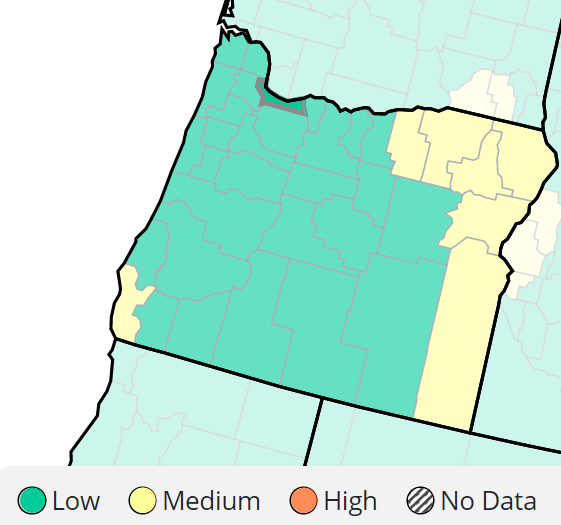
This Week’s Wastewater Monitoring Report: Number of Increases Doubles
With testing reports giving us just a fraction of infections out there, wastewater monitoring has become a more reliable indicator of the amount of virus in cities around the state. That report is updated each week.
This week’s report, updated on Wednesday, shows twice the number of increases and sustained increases (10%, the same as last week) as decreases and sustained decreases (20%, vs. 10% last week). Seventy percent showed no change (down from last week’s 80%).
Albany, Bend, Corvallis, and Port Orford, are the cities showing sustained increases in last week’s report.
From OHA: The Governor’s Healthcare Budget (from OHA weekly newsletter)
Gov. Kotek’s proposed budget boosts funds to address housing, mental health, and health coverage.
Gov. Tina Kotek released her proposed budget for the 2023-2025 biennium this week. The governor’s recommended two-year state spending plan proposes new funding to expand housing, address unmet behavioral health needs and protect and extend health coverage.
What does the budget mean for people in Oregon? Some of Governor Kotek’s health budget priorities include:
- New funds to eliminate health disparities and advance health equity.
- $245 million to protect health coverage for 1.4 million people on Oregon Health Plan (OHP, or Medicaid).
- Nearly $130 million to address homelessness, food insecurity and climate change through ground-breaking new benefits for eligible OHP members.
- Major investments giving more people access to mental health and substance use treatment, including $1.2 billion to sustain recent expansions in behavioral health treatment statewide, as well as $100 million in new funding to expand residential treatment for people who need mental health or substance use treatment.
- The governor’s budget would fund more than 300 new employees at Oregon State Hospital, which provides hospital care to people with severe psychiatric illness.
- Increasing access to reproductive health care statewide.
- More than $50 million to strengthen public health in communities across Oregon and prepare for emerging health threats by supporting OHA’s supply of personal protective equipment, vaccines and vaccine kits, tests and testing supplies and other medical equipment for use in response to a major disaster or public health emergency. If passed, the governor’s proposed budget would increase funding to Oregon Health Authority by 6.5%. The entire budget proposal can be found here, with the OHA breakdown beginning on page 61. Legislators will review and pass a final budget before the end of June.
COVID Q & A from OHA (from OHA weekly newsletter)
Dr. Paul Cieslak, OHA senior health advisor and medical director, Communicable Diseases and Immunizations, and Dr. Melissa Sutton, OHA’s medical director of respiratory viral pathogens, answered today’s questions.
Q: I had my bivalent COVID-19 vaccine (my 5th vaccine) in early September 2022, along with my flu shot. Since these vaccines wear off over time, will I be able to receive another COVID-19 and flu vaccine in 2023? If so, when? I am a senior with health issues. – Joy, Portland
A: “Regarding flu vaccination, just one dose is recommended for adults each season, and older persons and those at higher risk of severe disease should be vaccinated during September or October. The Centers for Disease Control and Prevention (CDC) notes that ‘in adults, studies have not shown a benefit from getting more than one dose of vaccine during the same influenza season, even among elderly persons with weakened immune systems.’ The flu vaccine gets updated every year with a new formula, so come next September you should definitely go out and get it.
“Regarding the COVID-19 vaccine, it sounds like you have received all the shots that are authorized and recommended. The bivalent booster you received in September is one dose only, and you are unable to receive another one until federal health officials authorize it. Currently, we do not expect that to happen within the next few months, but it could. It is likely, however, that next fall, along with a new flu shot, additional COVID-19 vaccinations or boosters will be authorized.”
Q: I find it hard to know how active COVID-19 is in my city (Corvallis) in real time. Is it possible to have a city/county rating system like we do for air quality: Green is good, yellow is low, orange is medium, red is take precautions, and purple is major surge and isolate? If there is a simple way to touch base each day, please let us know how to get to it easily. – John, Corvallis
A: “The CDC maintains a useful online color-coded system called COVID-19 Community Level (updated every Thursday) that you can use to learn COVID-19 levels in your county. The results for Benton County, where you live, show a low (green) level of COVID-19 activity, how that level was calculated (using multiple factors) and the recommended actions for that level. It also shows other COVID-19 data for Benton County, such as vaccination rates, hospitalizations, deaths and transmission rate.
“You can also look at Oregon’s SARS-CoV-2 Wastewater Monitoring Dashboard to see recent trends in COVID-19 levels and variants detected in wastewater. The dashboard shows that COVID-19 levels in Corvallis decreased at the end of December and have been flat since that time. The dashboard also shows that the emerging variant XBB has been detected in Corvallis at low levels recently.”
Additional COVID Updates and Links
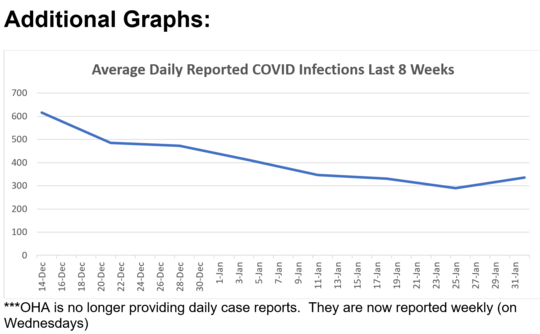

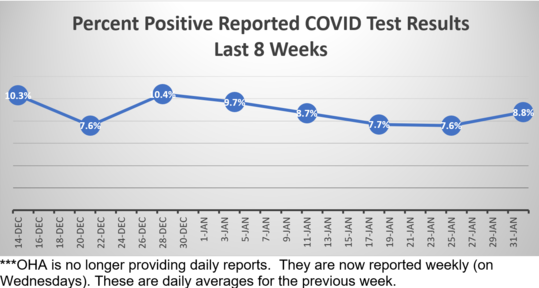

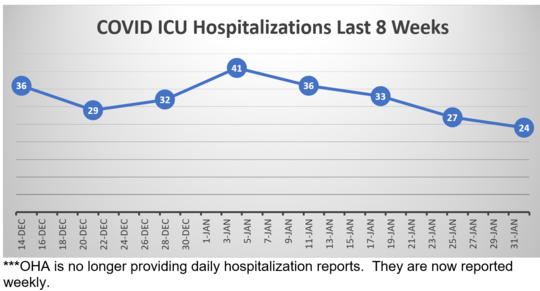
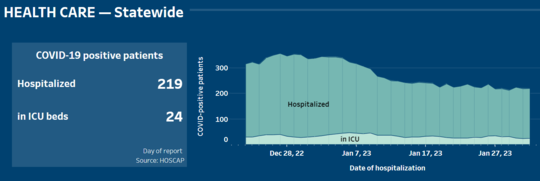
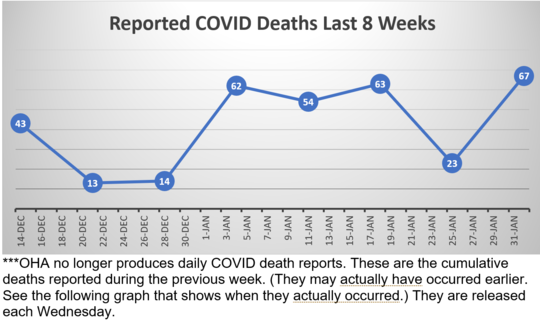

Here again are some COVID resources that you will find useful:
If the above links are not providing you with answers to your questions or directing you to the help that you need, please consider me and my office to be a resource. We’ll do our best to assist you or steer you in the right direction.
Want to See Past Newsletters?
If there was COVID-related information in a past newsletter that you want to go back to, but find you’ve deleted it, you can always go to my legislative website (senatordembrow.com), click on “News and Information,” and you’ll find them all there. Also, if someone forwarded you this newsletter and you’d like to get it directly, you can sign up for it there.
Best,
 Senator Michael Dembrow
District 23
email: Sen.MichaelDembrow@oregonlegislature.gov
web: www.senatordembrow.com
mail: 900 Court St NE, S-407, Salem, OR, 97301
|